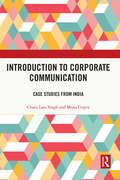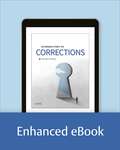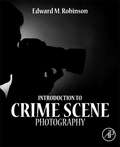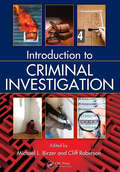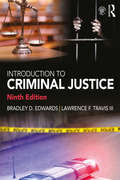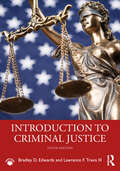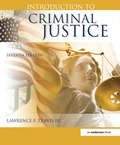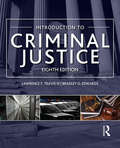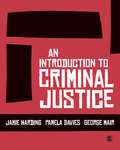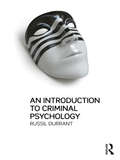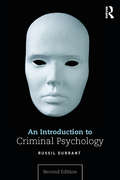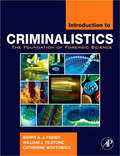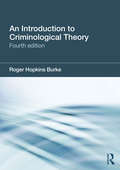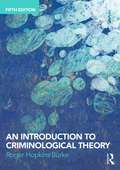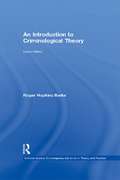- Table View
- List View
Introduction to Corporate Communication: Case Studies from India
by Charu Lata Singh Mona GuptaThis book examines the evolution of corporate communication in the recent past in the context of the rapidly changing contemporary business environment in India. Using several case studies, it illustrates the growing need for small and large businesses to recognize and form a direct connection with their stakeholders and further explains the effective ways through which specific business requirements are realized by communication managers. The book explores the greater dependency and function of multiple media strategies and their challenges. It also offers various theoretical and practical insights into the successful integration of diverse communication and marketing strategies like employee communication, investor relations, corporate social responsibility and philanthropy, branding, crisis management, and corporate ethics and governance, among others. Lucid and comprehensive, this book will be an essential read for students and scholars of corporate communications, business management, media and communication studies, public relations, and marketing, as well as communication and marketing practitioners.
Introduction to Corporate Communication: Case Studies from India
by Charu Lata Singh Mona GuptaThis book examines the evolution of corporate communication in the recent past in the context of the rapidly changing contemporary business environment in India. Using several case studies, it illustrates the growing need for small and large businesses to recognize and form a direct connection with their stakeholders and further explains the effective ways through which specific business requirements are realized by communication managers. The book explores the greater dependency and function of multiple media strategies and their challenges. It also offers various theoretical and practical insights into the successful integration of diverse communication and marketing strategies like employee communication, investor relations, corporate social responsibility and philanthropy, branding, crisis management, and corporate ethics and governance, among others. Lucid and comprehensive, this book will be an essential read for students and scholars of corporate communications, business management, media and communication studies, public relations, and marketing, as well as communication and marketing practitioners.
Introduction to Corrections
by Joycelyn PollockPollock's introductory text intends to present corrections in a new way for instructors who desire to prepare students in a problem-based, data-driven, media-savvy approach to achieve competency as correctional professionals or knowledgeable consumers of corrections' news. Each chapter will utilize current news and governmental reports along with academic studies, and have a discussion of race/ethnicity when appropriate.
Introduction to Crime Scene Photography
by Edward M. RobinsonIntroduction to Crime Scene Photography acquaints the reader with the essentials of basic crime scene photography techniques. It looks at the concepts related to composition and relates them to the types of photographs captured by crime scene photographers. It explains how to capture images based on the exposure settings chosen to produce the effect desired. It considers the techniques used needed to control and maximize Depth of Field (DOF), and reviews how the different lenses will affect an image. Organized into seven chapters, the book begins with an overview of crime scene photography and composition, including the three cardinal rules of good photography. It then proceeds with a discussion of the benefits of bounce flash and how to utilize this technique to properly compose the subject of interest. It also explains how to capture any image necessary at the crime scene by combining the concepts of composition, nonflash exposure, DOF, flash exposure, and the use of various types of lenses. In addition, the reader is introduced to various energy sources and filters, digital processing of evidentiary photography, and legal issues related to photographs and digital images. Examples and illustrations are provided throughout to demonstrate how the concepts examined tend to form a sort of symbiotic relationship. This text will benefit scene investigators and photographers, forensic consultants, forensic scientists, undergraduate students in forensic and/or criminal justice programs, law enforcement professionals, and anyone who wants to acquire the skills needed to be a successful crime scene photographer. Contains over 350 high-quality 4-color imagesRules of Thumb are included to highlight key concepts
Introduction to Criminal Investigation
by Michael L. Birzer Cliff RobersonThe manner in which criminal investigators are trained is neither uniform nor consistent, ranging from sophisticated training protocols in some departments to on-the-job experience alongside senior investigators in others. Ideal for students taking a first course in the subject as well as professionals in need of a refresher, Introduction to Criminal Investigation uses an accessible format to convey concepts in practical, concrete terms.Topics discussed include: The history of criminal investigation in Western society Qualifications for becoming an investigator, the selection process, and ideal training requirements Crime scene search techniques, including planning and post-search debriefing Preparing effective field notes and investigative reports Interviewing and interrogating Types of evidence found at the crime scene and how to collect, package, and preserve it The contributions of forensic science to criminal investigations and the equipment used in crime labs Investigative protocol for a range of crimes, including property crimes, auto theft, arson, financial crimes, homicide, assault, sex crimes, and robbery Specialized investigations, including drug trafficking, cybercrime, and gang-related crime Legal issues involved in criminal investigations and preparing a case for trial Bringing together contributions from law enforcement personnel, academics, and attorneys, the book combines practical and theoretical elements to provide a comprehensive examination of today‘s criminal investigative process. The accessible manner in which the information is conveyed makes this an ideal text for a wide-ranging audience.
Introduction to Criminal Investigation
by Michael Birzer Cliff RobersonThe manner in which criminal investigators are trained is neither uniform nor consistent, ranging from sophisticated training protocols in some departments to on-the-job experience alongside senior investigators in others. Ideal for students taking a first course in the subject as well as professionals in need of a refresher, Introduction to Criminal Investigation uses an accessible format to convey concepts in practical, concrete terms.Topics discussed include: The history of criminal investigation in Western society Qualifications for becoming an investigator, the selection process, and ideal training requirements Crime scene search techniques, including planning and post-search debriefing Preparing effective field notes and investigative reports Interviewing and interrogating Types of evidence found at the crime scene and how to collect, package, and preserve it The contributions of forensic science to criminal investigations and the equipment used in crime labs Investigative protocol for a range of crimes, including property crimes, auto theft, arson, financial crimes, homicide, assault, sex crimes, and robbery Specialized investigations, including drug trafficking, cybercrime, and gang-related crime Legal issues involved in criminal investigations and preparing a case for trial Bringing together contributions from law enforcement personnel, academics, and attorneys, the book combines practical and theoretical elements to provide a comprehensive examination of today‘s criminal investigative process. The accessible manner in which the information is conveyed makes this an ideal text for a wide-ranging audience.
Introduction to Criminal Justice
by Bradley D. Edwards Lawrence F. Travis IIIIntroduction to Criminal Justice, Ninth Edition, offers a student-friendly description of the criminal justice process—outlining the decisions, practices, people, and issues involved. It provides a solid introduction to the mechanisms of the criminal justice system, with balanced coverage of the issues presented by each facet of the process, including a thorough review of practices and controversies in law enforcement, the criminal courts, and corrections. In this revision, Edwards gives fresh sources of data, with over 600 citations of new research results. New sections include immigration policy, disparities in the justice system, Compstat and problem-oriented policing, victim services in the courts, and developments in drug policy. This edition also has expanded coverage of police use of force. Each chapter now includes a text box on a policy dilemma like cash bail or stop-and-frisk policies. Appropriate for all U.S. Criminal Justice programs, this text offers great value for students and instructors.
Introduction to Criminal Justice
by Bradley D. Edwards Lawrence F. Travis IIIIntroduction to Criminal Justice, Ninth Edition, offers a student-friendly description of the criminal justice process—outlining the decisions, practices, people, and issues involved. It provides a solid introduction to the mechanisms of the criminal justice system, with balanced coverage of the issues presented by each facet of the process, including a thorough review of practices and controversies in law enforcement, the criminal courts, and corrections. In this revision, Edwards gives fresh sources of data, with over 600 citations of new research results. New sections include immigration policy, disparities in the justice system, Compstat and problem-oriented policing, victim services in the courts, and developments in drug policy. This edition also has expanded coverage of police use of force. Each chapter now includes a text box on a policy dilemma like cash bail or stop-and-frisk policies. Appropriate for all U.S. Criminal Justice programs, this text offers great value for students and instructors.
Introduction to Criminal Justice
by Bradley D. Edwards Lawrence F. Travis IIIIntroduction to Criminal Justice, Tenth Edition, offers a student-friendly description of the criminal justice process—outlining the decisions, practices, people, and issues involved. It provides a solid introduction to the mechanisms of the criminal justice system, with balanced coverage of the issues presented by each facet of the process, including a thorough review of practices and controversies in law enforcement, the criminal courts, and corrections.In this revision, Edwards updates the statistics and research findings throughout. New sections include the impact of the COVID-19 pandemic, the recent shift to NIBRS crime reporting, and the increasing attacks on the legitimacy of the criminal justice system. This edition has also expanded coverage of police use of force and technological improvements. Selected chapters now include a case study box to demonstrate how certain laws, programs, and technologies have been used in particular situations.Appropriate for all U.S. criminal justice programs, this text offers great value for students and instructors.
Introduction to Criminal Justice
by Bradley D. Edwards Lawrence F. Travis IIIIntroduction to Criminal Justice, Tenth Edition, offers a student-friendly description of the criminal justice process—outlining the decisions, practices, people, and issues involved. It provides a solid introduction to the mechanisms of the criminal justice system, with balanced coverage of the issues presented by each facet of the process, including a thorough review of practices and controversies in law enforcement, the criminal courts, and corrections.In this revision, Edwards updates the statistics and research findings throughout. New sections include the impact of the COVID-19 pandemic, the recent shift to NIBRS crime reporting, and the increasing attacks on the legitimacy of the criminal justice system. This edition has also expanded coverage of police use of force and technological improvements. Selected chapters now include a case study box to demonstrate how certain laws, programs, and technologies have been used in particular situations.Appropriate for all U.S. criminal justice programs, this text offers great value for students and instructors.
Introduction to Criminal Justice
by Lawrence Travis IIIThis student-friendly introductory core text describes the criminal justice process in the United States - outlining the decisions, practices, people, and issues involved. It provides a solid introduction to the mechanisms of the criminal justice system, with balanced coverage of the issues presented by each facet of the process, including a thorough review of practices and controversies in law enforcement, the criminal courts, and corrections.
Introduction to Criminal Justice
by Lawrence F. Travis III Bradley D. EdwardsThis student-friendly introductory text describes the criminal justice process—outlining the decisions, practices, people, and issues involved. It provides a solid introduction to the mechanisms of the criminal justice system, with balanced coverage of the issues presented by each facet of the process, including a thorough review of practices and controversies in law enforcement, the criminal courts, and corrections.
Introduction to Criminal Justice
by Lawrence F. Travis III Bradley D. EdwardsThis student-friendly introductory text describes the criminal justice process—outlining the decisions, practices, people, and issues involved. It provides a solid introduction to the mechanisms of the criminal justice system, with balanced coverage of the issues presented by each facet of the process, including a thorough review of practices and controversies in law enforcement, the criminal courts, and corrections.
An Introduction to Criminal Justice (1st edition)
by George Mair Jamie Harding Pamela DaviesA contemporary guide to the criminal justice process, the broad scope of this book means it will be a trusted companion throughout a Criminology and/or Criminal Justice degree. The contents of An Introduction to Criminal Justice include: 23 chapters spanning all that’s involved with, and fully contextualising, the criminal justice process: the agencies, institutions and processes and procedures that deal with victims, offenders and offending A detailed timeline of criminal justice since 1945 Consideration of victims and witnesses, complaints and misconduct A comprehensive review of policing, prosecution, the courts, imprisonment and community sanctions A focus on community safety, crime prevention and youth justice A review of the effectiveness of the criminal justice process Exploration of global and international dimensions as well as the futures of criminal justice Lots of helpful extras including further reading suggestions, case studies, self-study questions and a glossary of terms. The accompanying website to An Introduction to Criminal Justice has: A podcast interview with a police officer Practice essay questions Multiple choice questions Suggested website resources to explore Videos.
An Introduction to Criminal Justice (1st edition) (PDF)
by George Mair Jamie Harding Pamela DaviesA contemporary guide to the criminal justice process, the broad scope of this book means it will be a trusted companion throughout a Criminology and/or Criminal Justice degree. The contents of An Introduction to Criminal Justice include: 23 chapters spanning all that’s involved with, and fully contextualising, the criminal justice process: the agencies, institutions and processes and procedures that deal with victims, offenders and offending A detailed timeline of criminal justice since 1945 Consideration of victims and witnesses, complaints and misconduct A comprehensive review of policing, prosecution, the courts, imprisonment and community sanctions A focus on community safety, crime prevention and youth justice A review of the effectiveness of the criminal justice process Exploration of global and international dimensions as well as the futures of criminal justice Lots of helpful extras including further reading suggestions, case studies, self-study questions and a glossary of terms. The accompanying website to An Introduction to Criminal Justice has: A podcast interview with a police officer Practice essay questions Multiple choice questions Suggested website resources to explore Videos.
An Introduction to Criminal Psychology
by Russil DurrantCrime is a topic that is of considerable interest to policy-makers, politicians andthe public alike. We want to know what factors can explain the nature andprevalence of crime in society and use this knowledge to better develop approaches for managing criminal behaviour. This book provides a comprehensive overview of approaches to understanding crime and criminal behaviour, with a focus on psychological perspectives. A wide range of different types of criminal behaviour are considered, including juvenile crime, violent offending, sexual offending, collective violence and drug use. For each type of offence a clear overview of key conceptual and methodological issues is provided, along with a detailed consideration of the major theoretical approaches that have been developed. The book concludes by considering how our theoretical understanding of crime can inform our responses to criminal behaviour in terms of punishment, prevention and rehabilitation. Key features of the book include: • an in-depth coverage of a broad range of different types of criminal behaviour; • inclusion of a diverse range of different theoretical perspectives; • accessibly written, with extensive use of case studies, boxes and activities; • an extensive use of up-to-date references that highlight the current state of knowledge in the field of criminal psychology. This book should be of interest to students, academics, researchers and practitioners with an interest in criminal behaviour, and is particularly suitable for undergraduate courses in criminal psychology, forensic psychology and psychological criminology.
An Introduction to Criminal Psychology
by Russil DurrantCrime is a topic that is of considerable interest to policy-makers, politicians andthe public alike. We want to know what factors can explain the nature andprevalence of crime in society and use this knowledge to better develop approaches for managing criminal behaviour. This book provides a comprehensive overview of approaches to understanding crime and criminal behaviour, with a focus on psychological perspectives. A wide range of different types of criminal behaviour are considered, including juvenile crime, violent offending, sexual offending, collective violence and drug use. For each type of offence a clear overview of key conceptual and methodological issues is provided, along with a detailed consideration of the major theoretical approaches that have been developed. The book concludes by considering how our theoretical understanding of crime can inform our responses to criminal behaviour in terms of punishment, prevention and rehabilitation. Key features of the book include: • an in-depth coverage of a broad range of different types of criminal behaviour; • inclusion of a diverse range of different theoretical perspectives; • accessibly written, with extensive use of case studies, boxes and activities; • an extensive use of up-to-date references that highlight the current state of knowledge in the field of criminal psychology. This book should be of interest to students, academics, researchers and practitioners with an interest in criminal behaviour, and is particularly suitable for undergraduate courses in criminal psychology, forensic psychology and psychological criminology.
An Introduction to Criminal Psychology
by Russil DurrantThis book offers a clear, up-to-date, comprehensive, and theoretically informed introduction to criminal psychology, exploring how psychological explanations and approaches can be integrated with other perspectives drawn from evolutionary biology, neurobiology, sociology, and criminology. Drawing on examples from around the world, it considers different types of offences from violence and aggression to white-collar and transnational crime, and links approaches to explaining crime with efforts to prevent crime and to treat and rehabilitate offenders. This revised and expanded second edition offers a thorough update of the research literature and introduces several new features, including: detailed international case studies setting the scene for each chapter, promoting real-world understanding of the topics under consideration; a fuller range of crime types covered, with new chapters on property offending and white-collar, corporate, and environmental crime; detailed individual chapters exploring prevention and rehabilitation, previously covered in a single chapter in the first edition; an array of helpful features including learning objectives, review and reflect checkpoints, annotated lists of further reading, and two new features: ‘Research in Focus’ and ‘Criminal Psychology Through Film’. This textbook is essential reading for upper undergraduate students enrolled in courses on psychological criminology, criminal psychology, and the psychology of criminal behaviour. Designed with the reader in mind, student-friendly and innovative pedagogical features support the reader throughout.
An Introduction to Criminal Psychology: An Introduction To Criminal Psychology
by Russil DurrantThis book offers a clear, up-to-date, comprehensive, and theoretically informed introduction to criminal psychology, exploring how psychological explanations and approaches can be integrated with other perspectives drawn from evolutionary biology, neurobiology, sociology, and criminology. Drawing on examples from around the world, it considers different types of offences from violence and aggression to white-collar and transnational crime, and links approaches to explaining crime with efforts to prevent crime and to treat and rehabilitate offenders. This revised and expanded second edition offers a thorough update of the research literature and introduces several new features, including: detailed international case studies setting the scene for each chapter, promoting real-world understanding of the topics under consideration; a fuller range of crime types covered, with new chapters on property offending and white-collar, corporate, and environmental crime; detailed individual chapters exploring prevention and rehabilitation, previously covered in a single chapter in the first edition; an array of helpful features including learning objectives, review and reflect checkpoints, annotated lists of further reading, and two new features: ‘Research in Focus’ and ‘Criminal Psychology Through Film’. This textbook is essential reading for upper undergraduate students enrolled in courses on psychological criminology, criminal psychology, and the psychology of criminal behaviour. Designed with the reader in mind, student-friendly and innovative pedagogical features support the reader throughout.
Introduction to Criminalistics: The Foundation of Forensic Science
by William J. Tilstone Barry A.J. Fisher Catherine WoytowiczIntroduction to Criminalistics covers the basics of Criminalistics in a textbook for a one or two semester course, with the intention of preparing the student for a future in forensic science. The role of the Criminalist is to analyze, compare, identify, and interpret physical evidence in the crime lab. These crime labs, or forensic labs, have two primary functions: identifying evidence and linking the suspect, victim, and crime scene through physical evidence. This new primer introduces the learner to the structure and organization of the crime lab and to the role of the Criminalist. It features real cases – recent and historic – to illustrate concepts. Colorful pedagogy clearly defines chapter elements and sets this text apart from next best. Topics covered include how to process a crime scene and preserve evidence, the basic principles of firearm examination, latent fingerprints, and rudimentary toxicology, or how to determine the presence or absence of drugs and poisons. Well organized and methodical, this textbook has the potential to become the standard text for applying techniques of the physical and natural sciences to examining physical evidence. Uses real cases – recent and historic – to illustrate conceptsColorful pedagogy clearly defines chapter elements and sets this text apart from next bestPresents the basics of forensic sciences in a one-semester or one-year courseOffers excellent preparation for professional examinationsDelivers the latest in laboratory technique while acknowledging the limits of technology
An Introduction to Criminological Theory: An Introduction To
by Roger Hopkins BurkeThis book provides a comprehensive and up-to-date introduction to criminological theory for students taking courses in criminology at both undergraduate and postgraduate level. Building on previous editions, which broadened the debate on criminological theory, this book presents the latest research and theoretical developments. The text is divided into five parts, the first three of which address ideal type models of criminal behaviour: the rational actor, predestined actor and victimized actor models. Within these, the various criminological theories are located chronologically in the context of one of these different traditions, and the strengths and weaknesses of each theory and model are clearly identified. The fourth part of the book looks closely at more recent attempts to integrate theoretical elements from both within and across models of criminal behaviour, while the fifth part addresses a number of key recent concerns of criminology: postmodernism, cultural criminology, globalization and communitarianism. All major theoretical perspectives are considered, including: classical criminology, biological and psychological positivism, labelling theories, feminist criminology, critical criminology and left realism, social control theories, the risk society. The new edition also features comprehensive coverage of recent developments in criminology, including situation action theory, desistance theory, peacemaking criminology, Loïc Wacquant’s thesis of the penal society, critical race theory and Southern theory. This revised and expanded fourth edition of An Introduction to Criminological Theory includes chapter summaries, critical thinking questions, a full glossary of terms and theories and a timeline of criminological theory, making it essential reading for those studying criminology.
An Introduction to Criminological Theory
by Roger Hopkins BurkeThis book provides a comprehensive and up-to-date introduction to criminological theory for students taking courses in criminology at both undergraduate and postgraduate level. Building on previous editions, which broadened the debate on criminological theory, this book presents the latest research and theoretical developments. The text is divided into five parts, the first three of which address ideal type models of criminal behaviour: the rational actor, predestined actor and victimized actor models. Within these, the various criminological theories are located chronologically in the context of one of these different traditions, and the strengths and weaknesses of each theory and model are clearly identified. The fourth part of the book looks closely at more recent attempts to integrate theoretical elements from both within and across models of criminal behaviour, while the fifth part addresses a number of key recent concerns of criminology: postmodernism, cultural criminology, globalization and communitarianism. All major theoretical perspectives are considered, including: classical criminology, biological and psychological positivism, labelling theories, feminist criminology, critical criminology and left realism, social control theories, the risk society. The new edition also features comprehensive coverage of recent developments in criminology, including situation action theory, desistance theory, peacemaking criminology, Loïc Wacquant’s thesis of the penal society, critical race theory and Southern theory. This revised and expanded fourth edition of An Introduction to Criminological Theory includes chapter summaries, critical thinking questions, a full glossary of terms and theories and a timeline of criminological theory, making it essential reading for those studying criminology.
An Introduction to Criminological Theory
by Roger Hopkins BurkeThis book provides a comprehensive and up-to-date introduction to criminological theory for students taking courses in criminology at both undergraduate and postgraduate level. Building on previous editions, this book presents the latest research and theoretical developments. The text is divided into five parts, the first three of which address ideal type models of criminal behaviour: the rational actor, predestined actor and victimized actor models. Within these, the various criminological theories are located chronologically in the context of one of these different traditions, and the strengths and weaknesses of each theory and model are clearly identified. The fourth part of the book looks closely at more recent attempts to integrate theoretical elements from both within and across models of criminal behaviour, while the fifth part addresses a number of key recent concerns of criminology: postmodernism, cultural criminology, globalization and communitarianism, the penal society, southern criminology and critical criminology. All major theoretical perspectives are considered, including: classical criminology, biological and psychological positivism, labelling theories, feminist criminology, critical criminology and left realism, situation action, desistance theories, social control theories, the risk society, postmodern condition and terrorism. The new edition also features comprehensive coverage of recent developments in criminology, including ‘the myth of the crime drop’, the revitalization of critical criminology and political economy, shaming and crime, defiance theory, coerced mobility theory and new developments in social control and general strain theories. This revised and expanded fifth edition of An Introduction to Criminological Theory includes chapter summaries, critical thinking questions, policy implications, a full glossary of terms and theories and a timeline of criminological theory, making it essential reading for those studying criminology and taking courses on theoretical criminology, understanding crime, and crime and deviance
An Introduction to Criminological Theory (Criminal Justice: Contemporary Literature in Theory and Practice)
by Roger Hopkins BurkeFirst Published in 1997. Routledge is an imprint of Taylor & Francis, an informa company.
An Introduction to Criminological Theory
by Roger Hopkins BurkeThis book provides a comprehensive and up-to-date introduction to criminological theory for students taking courses in criminology at both undergraduate and postgraduate level. Building on previous editions, this book presents the latest research and theoretical developments. The text is divided into five parts, the first three of which address ideal type models of criminal behaviour: the rational actor, predestined actor and victimized actor models. Within these, the various criminological theories are located chronologically in the context of one of these different traditions, and the strengths and weaknesses of each theory and model are clearly identified. The fourth part of the book looks closely at more recent attempts to integrate theoretical elements from both within and across models of criminal behaviour, while the fifth part addresses a number of key recent concerns of criminology: postmodernism, cultural criminology, globalization and communitarianism, the penal society, southern criminology and critical criminology. All major theoretical perspectives are considered, including: classical criminology, biological and psychological positivism, labelling theories, feminist criminology, critical criminology and left realism, situation action, desistance theories, social control theories, the risk society, postmodern condition and terrorism. The new edition also features comprehensive coverage of recent developments in criminology, including ‘the myth of the crime drop’, the revitalization of critical criminology and political economy, shaming and crime, defiance theory, coerced mobility theory and new developments in social control and general strain theories. This revised and expanded fifth edition of An Introduction to Criminological Theory includes chapter summaries, critical thinking questions, policy implications, a full glossary of terms and theories and a timeline of criminological theory, making it essential reading for those studying criminology and taking courses on theoretical criminology, understanding crime, and crime and deviance
